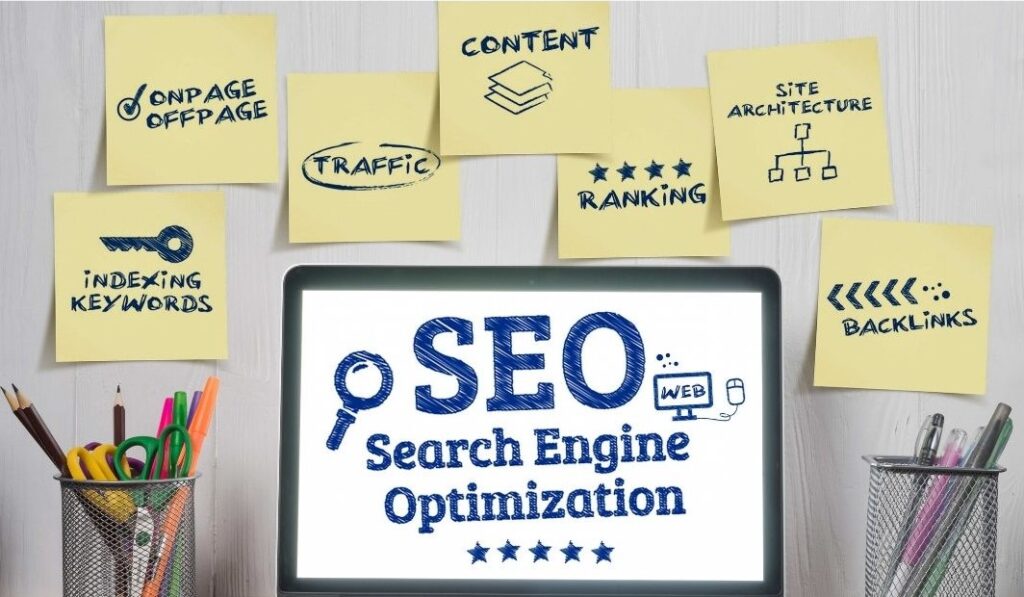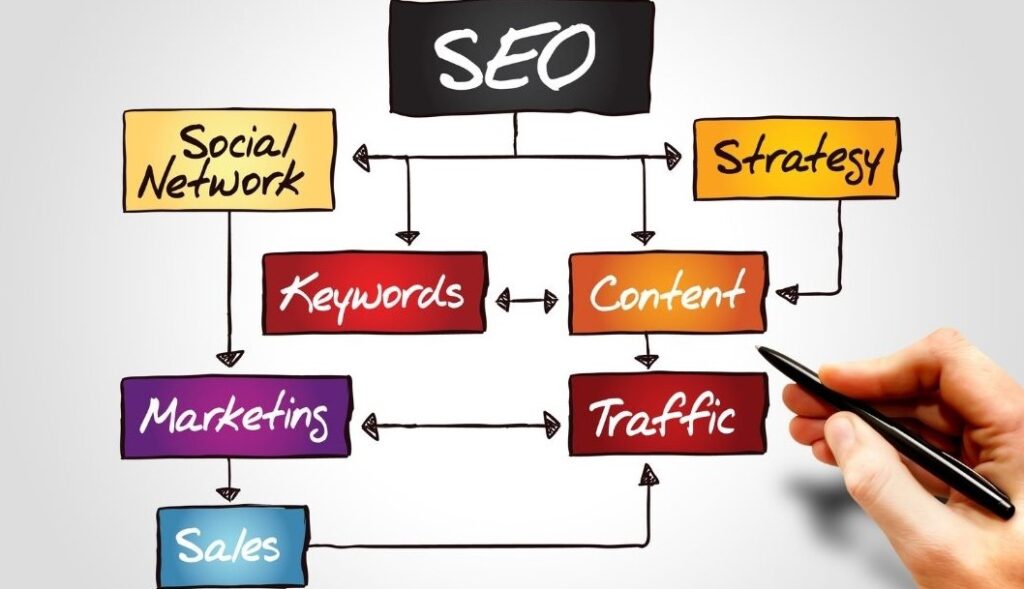In today’s digital age, having a robust online presence is essential for success, and Search Engine Optimization (SEO) is a key component in making that happen. This guide will walk you through the fundamentals of SEO and how it can help your business stand out in search engine results, attract more customers, and drive growth. Whether you’re new to SEO or looking to enhance your current strategy, understanding these core principles will set you on the path to achieving greater visibility and reaching your business goals. Let’s explore how SEO can transform your online presence and contribute to your business’s success.
Search Engine Optimization Key Takeaways
- SEO is Crucial for Visibility: SEO makes your business more visible online, attracting customers and driving growth.
- Benefits of SEO: SEO boosts traffic, builds credibility, is cost-effective, attracts the right audience, keeps you competitive, and enhances local visibility.
- Core Elements of SEO: Focus on keyword research, quality content, on-page and technical SEO, backlinks, and user experience.
- Local SEO Strategies: Optimize your Google My Business profile, use local keywords, create local content, and engage on social media to boost local presence.
- Use SEO Tools: Tools like Google Analytics, SEMrush, and Yoast SEO can help optimize your site and track performance.
- Continuous Improvement: SEO is ongoing; regularly monitor, adjust, and stay updated with trends.
- Professional Help: Consider hiring an SEO professional to save time and ensure a tailored strategy for your business.
What is SEO Search Engine Optimization?
SEO is crucial for your online business. Think of it this way: You have a stunning store located on a busy street, but due to its unfortunate positioning behind a massive building, nobody knows it exists. The same goes for your website. Without SEO, your website remains hidden from potential customers who are actively searching for the products or services you offer. However, with effective SEO, your website becomes more prominent, attracting higher traffic and ultimately resulting in increased business.
In simple terms, Search Engine Optimization is the combination of art and science that enables your website to rank higher in search engine results pages (SERPs). By optimizing your website, you make it easier for search engines like Google to understand its content and value, positioning it among the top spots when users search for related terms.
Six Benefits of SEO
A website without search engine optimization faces not being found – lost amidst the endless searches on the internet. The key lies in enhancing your business’s visibility to online searchers. The stronger your SEO, the simpler it becomes for potential customers to discover your digital presence. Here are six benefits to your business if you utilize SEO for your website:
- Boost Traffic, Boost Sales – The primary goal of SEO is to increase your website’s traffic by improving your ranking on search engines like Google. When your site ranks higher, more people will click on it, leading to more visitors and, ultimately, more sales. It’s like placing your store right in the middle of a bustling marketplace.
- SEO Adds Credibility and Trust – People trust search engines. If your website appears at the top of search results, it automatically gains credibility. Customers are more likely to trust and do business with you if they find you easily. Think of SEO as earning a “stamp of approval” from search engines.
- SEO for Cost-Effective Marketing – Unlike other marketing strategies that can cost a pretty penny, SEO is relatively cost-effective. While it does require an investment of time and resources, the long-term benefits far outweigh the costs. Once your website begins to climb the rankings, the ongoing maintenance is minimal compared to the initial work.
- SEO to Attract the Right Audience – SEO isn’t just about getting more visitors; it’s about getting the right visitors. Through keyword research and analytics, you can understand what your customers are searching for and tailor your content to meet their needs. This means higher engagement and better conversion rates.
- SEO Helps Stay Ahead of the Competition – Your competitors are likely already leveraging SEO. By neglecting it, you risk falling behind. By investing in it, you ensure that you stay ahead of the curve and maintain your competitive edge.
- Local SEO Benefits – Local SEO is a game-changer. It helps you attract customers who are specifically looking for services or products in your area. Optimizing for local search terms can drive foot traffic to your physical store and boost your online presence.
Six Key Elements of Effective SEO
 SEO might sound complex, but breaking it down into its key elements can make it a lot more manageable. Let’s explore the essential components you need to know to make your Roseville business shine online.
SEO might sound complex, but breaking it down into its key elements can make it a lot more manageable. Let’s explore the essential components you need to know to make your Roseville business shine online.
1. Keyword Research:
Keywords are the bread and butter of optimizing for search. Start by thinking about what potential customers are typing into search engines. Tools like Google Keyword Planner or Ubersuggest can help you uncover the terms people are searching for.
Here’s a pro tip: don’t just focus on high-traffic keywords. Long-tail keywords (those longer, more specific phrases) often have less competition and can drive highly targeted traffic to your site.
2. High-Quality Content:
Content isn’t just king; it’s the entire kingdom! Your content should provide value, answer questions, and engage your audience. Use a mix of text, videos, infographics, and other formats on your blog or pages to keep things interesting. Most importantly, make sure your content is original and relevant to your audience.
3. On-Page SEO: Fine-Tuning Your Content
On-page SEO involves optimizing individual pages on your website. Here are some key tactics:
- Title Tags: Create descriptive and compelling titles that include your primary keywords.
- Meta Descriptions: Write concise descriptions that encourage users to click on your link.
- Header Tags (H1, H2, H3): Organize your content with header tags to improve readability and SEO.
- Image Alt Text: Use descriptive alt text for images to help search engines understand your content.
- Internal Linking: Link to other pages on your site to help users and search engines navigate better.
4. Technical SEO: The Backbone of Your Site
Ensure that your website meets the technical requirements of search engines. While it might sound intimidating, here’s what you need to focus on:
- Mobile-Friendliness: Ensure your site is responsive and works well on mobile devices.
- Site Speed: Fast-loading pages improve user experience and rank better.
- XML Sitemaps: Submit a sitemap to search engines to help them understand your site structure.
- Secure Sockets Layer (SSL): Use HTTPS to ensure your site is secure.
5. Backlinks: Building Your Authority
Backlinks are like votes of confidence from other websites. When reputable sites link to yours, it signals to search engines that your content is valuable. Here’s a few ways to build quality backlinks:
- Guest Posting: Write articles for other industry-related websites.
- Influencer Outreach: Connect with influencers who might share your content.
- Content Creation: Produce high-quality, shareable content that others want to link to.
- Business Directories: Add your business to high quality directory sites and make sure your business details match what is on your website.
6. User Experience (UX): Keeping Visitors Happy
Last but definitely not least, think about your users. A positive user experience encourages visitors to stay on your site longer and explore more pages. This can reduce bounce rates and signal search engines that your site is valuable. Focus on easy navigation, clean design, and relevant content.
Local SEO Strategies for Businesses
 Local Search Engine Optimization is your ticket to achieving just that. Let’s get into some practical and effective local strategies that can significantly boost your visibility in the Roseville area.
Local Search Engine Optimization is your ticket to achieving just that. Let’s get into some practical and effective local strategies that can significantly boost your visibility in the Roseville area.
1. Optimize Your Google My Business Profile
First things first, Google My Business (GMB) is essential. If you don’t already have a GMB profile, create one today! This free tool allows you to control how your business appears on Google Search and Maps.
- Ensure your business name, address, and phone number (NAP) are accurate and consistent.
- Add a detailed description of your business, including keywords relevant to your industry.
- Upload high-quality photos of your business premises, products, or services.
- Encourage satisfied customers to leave positive reviews, and respond to them promptly.
- Continue to optimize your GMB with new content and as your company has updates.
2. Local Keywords Are Your Best Friend
Keywords are the backbone of SEO, and local keywords are vital for attracting customers nearby. Think about what potential customers in your area might be searching for. Use tools like Google Keyword Planner or Ubersuggest to find relevant local keywords.
- Incorporate these keywords naturally into your website content.
- Use them in your URL, image alt text, meta titles, and descriptions.
- Mention local landmarks or community events in your blog posts if applicable.
3. Create Quality Local Content
Creating quality, locally-focused content can set you apart from the competition. Think about blogging or creating videos about local events, news, or industry trends relevant to your local area.
- Share local success stories or customer testimonials.
- Write guides or how-tos that appeal to local residents.
- Collaborate with other local businesses or influencers for mutual promotion.
4. Get Listed in Local Directories
Besides Google My Business, there are numerous other local online directories where you should list your business. Examples include Yelp, Yellow Pages, and Bing Places. Ensure your information is consistent across all platforms to build trust and authority.
- Check and update your listings regularly.
- Respond to reviews and feedback.
- Provide as much information as possible, including hours of operation, services offered, and special promotions.
5. Utilize Social Media for Local Engagement
Social media isn’t just for selfies and cat videos. It’s a powerful tool for local engagement. Platforms like TikTok, Facebook, Instagram, and Twitter can help you connect with your local community.
- Post regularly about your business, special offers, and events.
- Engage with local followers by responding to comments and messages.
- Run promotions or contests specifically for your local audience.
6. Build Local Backlinks
Backlinks from reputable local websites can enhance your SEO. Reach out to local bloggers, news sites, and industry publications for opportunities to contribute guest posts, share press releases, or collaborate on content.
By implementing these strategies, your business can climb the local search rankings and attract more customers right from your community. Remember, local SEO is an ongoing process, so keep refining your approach and stay engaged with your local audience.
Tools and Resources for Search Engine Optimization
SEO can significantly boost your online visibility and drive more organic traffic to your website. However, optimizing your site can be complex and time-consuming without the right tools. In this section, we’ll introduce you to some fantastic tools and resources that can help you optimize your website like a pro, streamline your SEO efforts, and achieve better results.
Why Use SEO Tools?
Before we jump into the list, let’s quickly understand why using SEO tools is essential. These tools can help you:
- Identify the best keywords for your business
- Analyze your competitors
- Track your website’s performance
- Find and fix on-page issues
- Build quality backlinks
Top Tools You Should Consider
- Google Analytics. This free tool from Google is a must-have. It helps you understand your website traffic, user behavior, and much more. You can see how visitors are finding your site and which pages are performing well.
- Google Search Console. Another free tool from Google, Search Console lets you monitor and maintain your site’s presence in Google search results. It helps you understand how Google views your site and troubleshoot issues.
- SEMrush. This comprehensive tool offers keyword research, competitor analysis, backlink tracking, and site audit features. It’s a bit pricier, but many businesses find it worth the investment.
- Ahrefs. Known for its powerful backlink analysis capabilities, Ahrefs also offers keyword research, competitor analysis, and rank tracking. It’s a great all-in-one SEO tool.
- Yoast SEO or RankMath. If you’re using WordPress, these are two fantastic plugin that helps you optimize your content for search engines. They provide real-time feedback on your content’s performance.
 SEO Resources to Keep You Updated
SEO Resources to Keep You Updated
SEO is always changing, so it’s crucial to stay updated with the latest trends and best practices. Here are some excellent resources:
- Moz Blog. Moz is a well-respected name in the SEO world. Their blog offers insights, how-tos, and the latest news in SEO.
- Search Engine Journal. This site provides comprehensive articles, guides, and news on everything SEO. It’s a great place to learn from industry experts.
- Google Search Essentials. These guidelines are essential for understanding what Google expects from your website. Following these can help you avoid penalties and improve your site’s ranking.
Community and Support
Sometimes, you need a little help from your friends. Joining Search Engine Optimization communities can provide valuable support and advice:
- SEO Subreddit: A friendly place to ask questions and share insights.
- SEO Facebook Groups: There are many groups where you can connect with other enthusiasts and professionals.
- Local Meetups: Look for SEO meetups in your local area to network and learn from others.
With these in your toolkit, you’ll be well on your way to optimizing your website and boosting your online presence.
Case Study: Brand Lift 360 & Search Engine Optimization
Discover how our very own company, a Roseville-based digital marketing agency, has helped its clients achieve remarkable growth by enhancing their online visibility, driving organic traffic, and improving search engine rankings.
The Challenge
One of their clients, a mid-sized furniture store in Roseville, was struggling to attract local customers despite having a fantastic showroom and great prices. They needed more foot traffic and higher online sales, but their website was buried on page four of Google search results. That’s where Brand Lift 360 came in.
The Strategy
Our team developed a comprehensive SEO strategy tailored to the furniture store’s unique needs. Here’s a breakdown of what we did:
- Keyword Research: We started with extensive keyword research to identify the terms potential customers were using to search for furniture in Roseville.
- On-Page Optimization: We optimized the store’s website by incorporating these keywords into meta titles, descriptions, headers, and content. Our team also improved site speed and mobile responsiveness, crucial factors for SEO.
- Content Creation: Quality content is king. We helped the furniture store create engaging blog posts, how-to guides, and videos that addressed common customer questions and showcased their products.
- Local SEO: Knowing the importance of local searches, we optimized the store’s Google My Business profile, ensuring accurate information and encouraging satisfied customers to leave positive reviews.
- Link Building: Our team also reached out to local bloggers and websites to build high-quality backlinks, enhancing the store’s online authority and credibility.
The Results
The results were nothing short of phenomenal! Within six months, the furniture store saw a significant increase in organic traffic, jumping from page four to the top of page one on Google search results for several key terms. Here are some of the highlights:
- Increased Organic Traffic: Website traffic grew by 75%, driving more potential customers to their site.
- Higher Conversion Rates: The improved user experience and targeted content led to a 18% increase in online sales.
- Boosted Local Visibility: The store’s Google My Business profile saw a 45% increase in views and interactions, translating to more foot traffic in their showroom.
This case study highlights the power of a well-executed SEO strategy. If Brand Lift 360 can transform a struggling local furniture store into a thriving business, imagine what a solid strategy can do for your business.
From understanding why SEO matters to diving into local strategies and key elements, you’ve got a solid foundation. Remember, it’s all about making your business more visible online, attracting the right customers, and ultimately driving growth. The effort you put into optimizing your online presence isn’t just a one-time task; it’s an ongoing process that evolves with your business.
Your Next Steps to SEO
Now that you’re equipped with the knowledge, it’s time to take action. Here are a few steps to get you started:
- Assess Your Current SEO: Take a good look at your existing website and online presence. Use tools like Google Analytics and Google Search Console to understand where you stand.
- Set Clear Goals: Define what you want to achieve with your SEO efforts. Whether it’s increasing website traffic, improving local search rankings, or boosting online sales, setting clear goals will guide your strategy.
- Optimize Your Website: Implement the key elements on your website. This includes optimizing your content, meta tags, and images, and ensuring your site is mobile-friendly.
- Create High-Quality Content: Start a blog or update your existing content with valuable, relevant information that your audience cares about. Aim to become a go-to resource in your industry.
- Engage Locally: Claim and optimize your Google My Business listing. Encourage satisfied customers to leave reviews, and engage with your local community both online and offline.
- Monitor and Adjust: Regularly check your website’s performance and make adjustments as needed. It’s a long-term strategy, so stay patient and consistent.
Resources to Keep You On Track
There’s a wealth of resources out there to support your journey. Here are a few that can be particularly helpful:
- Google Search Central Help Community
- Moz’s Beginner’s Guide to SEO
- Ahrefs’ SEO Basics
- Google’s SEO Starter Guide
- SEMrush Academy
Learn Search Engine Optimization
The world of SEO is always changing, so staying updated is crucial. Join online communities, follow industry blogs, and perhaps even attend local or virtual workshops. Connect with fellow business owners in your local area to share experiences and tips. You never know where the next big breakthrough might come from!
Feeling a bit overwhelmed? That’s totally normal. SEO can seem like a vast ocean, but remember, you don’t have to navigate it alone. Whether you decide to take it on yourself or seek professional assistance, there’s support available to you. And if you ever need a helping hand, our team at Brand Lift 360 is always ready to assist you in boosting your online presence and achieving your business goals.
Happy Optimizing!
Contact Brand Lift 360 for Search Engine Optimization (SEO) services
Search Engine Optimization FAQs
1. What is SEO? Search Engine Optimization is the practice of improving your website’s visibility in search engine results pages (SERPs) to attract more organic traffic. It involves optimizing various elements of your website to meet the criteria that search engines use to rank pages.
2. How do search engines work? Search engines use algorithms to crawl, index, and rank web pages based on their relevance and quality. They assess various factors, such as keywords, site structure, and backlinks, to determine how well a page matches a user’s search query.
3. What are keywords, and why are they important? Keywords are specific words or phrases that users type into search engines when looking for information. Incorporating relevant keywords into your website’s content helps search engines understand what your pages are about, improving your chances of ranking higher for those terms.
4. What is on-page SEO? On-page SEO refers to optimizing individual pages on your website to improve their search engine rankings. This includes optimizing title tags, meta descriptions, headers, content, images, and internal links.
5. What is off-page SEO? Off-page SEO involves activities outside your website that can impact your rankings, such as building backlinks from other reputable sites, social media marketing, and online reputation management.
6. How does mobile-friendliness affect SEO? Mobile-friendliness is crucial because search engines prioritize sites that provide a good user experience on mobile devices. A responsive design that adapts to various screen sizes can improve your rankings and ensure users have a positive experience.
7. How long does it take to see results from SEO? SEO is a long-term strategy, and results can vary. Generally, it may take several months to start seeing significant improvements in rankings and traffic. Consistency and ongoing optimization are key to achieving and maintaining results.
8. What are backlinks, and why are they important? Backlinks are links from other websites that point to your site. They are important because they signal to search engines that your content is valuable and authoritative. High-quality backlinks can improve your site’s credibility and ranking.
9. What are common SEO mistakes to avoid? Common mistakes include keyword stuffing, neglecting mobile optimization, ignoring meta tags, and failing to update content regularly. Avoiding these pitfalls and focusing on quality and relevance will help improve your efforts.
10. Do I need to hire an SEO professional? While it’s possible to manage SEO on your own, hiring a professional or agency like Brand Lift 360 can provide expertise and save you time. They can develop and execute a comprehensive strategy tailored to your business needs.












